Sector-specific Cash and Voucher Assistance
CVA can help people in crises address their needs within a specific humanitarian sector, such as water, food, health, shelter, livelihood, or protection. Sector-specific CVA can be restricted or unrestricted, and conditional or unconditional, and will typically be provided as part of a comprehensive package which may also include in-kind and service-based assistance.
Each sector has to consider different questions, challenges, advantages and risks when it comes to supporting people’s recovery within their area of expertise. This requires evidence, tools, guidance and capacity. Meeting sector-specific outcomes through CVA also requires a multi-sectoral understanding of needs and of household economic security – see Multipurpose Cash Assistance. While some sectors are very experienced in implementing CVA and have done so for many years, others are now catching up. Most humanitarian sectors are committed and have been increasing their efforts on sector-specific CVA. The Global Cluster Coordination Group (GCCG) is also coordinating cross-cluster work to improve the sectoral used of CVA.
Current priorities
The CALP Network works closely with the cash technical groups/task teams within the global clusters, who have been defining their 2020 priorities and workplans during their regular meetings. A general overview and specific details of these priorities across each global cluster is available here.
Sector-specific CVA subpages
Camp Coordination, Camp Management and Cash and Voucher Assistance
Page
Find out more about Camp Coordination and Camp Management (CCCM) in relation to Cash and Voucher Assistance (CVA). For the most up to date information visit the Global CCCM Cluster’s website.
Education and Cash and Voucher Assistance
Page
A brief introduction as to how Cash and Voucher Assistance (CVA) can support education outcomes. For the most up to date information please visit the Global Education Cluster’s website.
Food Security and Cash and Voucher Assistance
Page
A brief introduction as to how Cash and Voucher Assistance (CVA) can support food security outcomes. For the most up to date information please visit the Food Security Cluster Cash and Market Working Group web page.
Health and Cash and Voucher Assistance
Page
The content on this webpage has been developed with the Global Health Cluster.
Nutrition and Cash and Voucher Assistance
Page
Malnutrition continues to pose a major challenge to human well-being around the world. In 2020, an estimated 144 million children under five suffer from stunting (i.e. chronic malnutrition) , 47 million children under five were wasted (i.e. acute malnutrition) , of which 14.3 million were severely wasted, and an additional 340 million suffered from micronutrient deficiencies (UNICEF/WHO/WB...
Protection and Cash and Voucher Assistance
Page
How can Cash and Voucher Assistance (CVA) support protection outcomes? Please find a brief summary below, and for the very latest information, refer to the Global Protection Cluster Task Team on Cash for Protection.
Shelter and Cash and Voucher Assistance
Page
How can Cash and Voucher Assistance (CVA) support shelter outcomes? Please find a brief summary below, and for the very latest information, refer to the Shelter and Cash Working Group.
WASH and Cash and Voucher Assistance
Page
How can Cash and Voucher Assistance (CVA) support WASH outcomes? Please find a brief summary below, and for the very latest information, refer to the WASH Cluster’s Cash and Markets Technical Working Group.
Latest

Vouchers – A quick delivery guide for cash transfer programming in emergencies
Guidelines and Tools
A quick delivery guide to using vouchers to implement a market-based emergency response. Prepared as a practical tool, this guide provides a brief synthesis of the necessary preconditions and advantages and disadvantages of using vouchers. It also provides practical implementation tips.
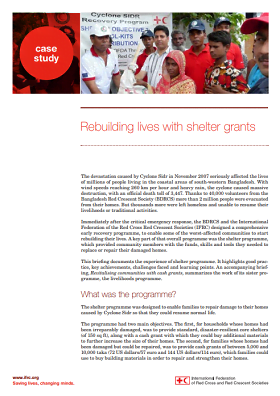
Rebuilding lives with shelter grants
Case Study
Bangladesh following the devastation caused by Hurricane Sidr in 2007. Part of the overall programme was the shelter programme, which provided community members with the funds, skills and tools they needed to replace or repair their damaged homes. Dependent on the damage to the homes, households were...
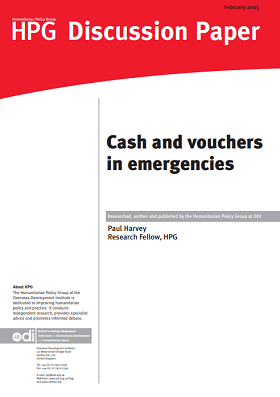
Cash and Vouchers in Emergencies
Report
This HPG discussion paper examines all aspects of using cash and vouchers to assist people in emergency situations. It provides a background to the literature and theory around cash and vouchers, looks at the current picture through selected examples and examines the decision making process on the...
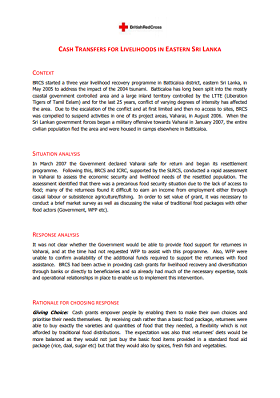
Cash transfers for livelihoods in Eastern Sri Lanka
Case Study
This case study looks at the British Red Cross’ intervention in Eastern Sri Lanka, following the Tsunami, whereby resettled households were provided with the cash equivalent of a food ration in order to bridge the gap before the next harvest and resumption of livelihood activities. The paper discusses...

Planning and implementing cash transfers in emergencies: Practical insights from Pakistan
Report
Access The Report Here The use of cash transfers and vouchers, or together ‘cash-based responses’, has grown remarkably in recent years. Cash transfers provide beneficiaries with money, while vouchers ensure access to food for a predefined quantity or value in identified outlets. While there is a...
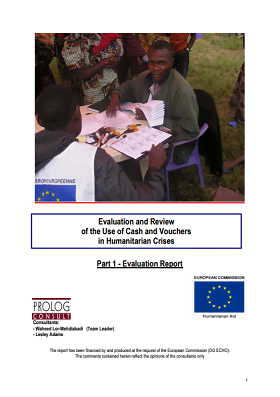
Evaluation and Review of the Use of Cash and Vouchers in Humanitarian Crises
Report
This report is the second of two reports commissioned by DG ECHO to support the development of a coherent policy regarding the use of cash and vouchers in humanitarian crises. The first report evaluated DG ECHO’s partners’ use of cash and vouchers. This second report reviews cash and voucher...
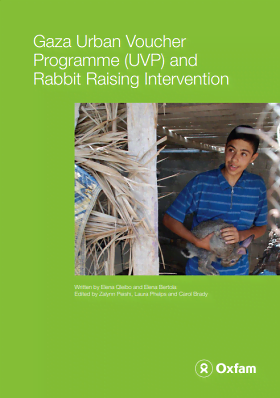
Gaza Urban Voucher Programme (UVP) and Rabbit Raising Intervention
Case Study
This case study looks at an Oxfam commodity voucher programme which supported households to improve their access to food, as well as a rabbit rearing intervention to help protect the livelihoods of unemployed people in the Gaza. The document looks at the rationale for programme choice, the project...

Support to Economic Recovery of Urban Households in Karoi town, Zimbabwe (the CALP Network Case Study)
Report
In the urban area of Karoi, Zimbabwe, Save the Children combined cash for work with livelihoods support to meet the immediate food needs and support the economic recovery of poor families. The project used smart cards to transfer cash to beneficiaries, which proved to be an appropriate payment...
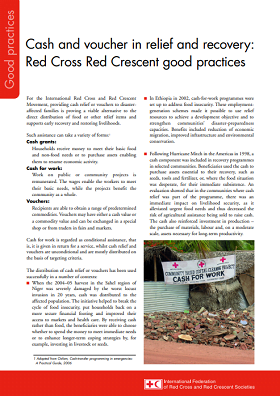
Cash and voucher in relief and recovery: Red Cross Red Crescent good practices
Report
A two-page brief giving some examples of the Red Cross / Red Crescent movement’s experience using cash grants, vouchers, and cash-for-work in emergency response.
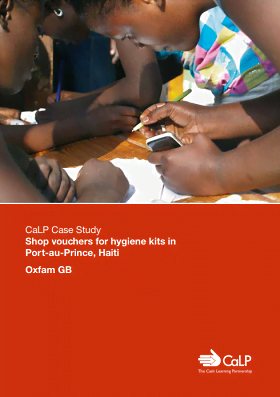
Shop vouchers for hygiene kits in Port-au-Prince, Haiti (the CALP Network Case Study)
Report
In the aftermath of the 2010 Haiti earthquake, Oxfam’s Public Health Promotion team used a voucher programme to provide beneficiaries with essential hygiene items through local shops. The voucher system was chosen so that beneficiaries could access hygiene items in a normal and dignified way, and in...

Evaluation of Livelihoods Projects Sri Lanka Tsunami Specific Plan
Report
Spanish Red Cross has wide experience in livelihoods programming mainly in South America and South Africa over the last twenty years. However the projects that were developed in response to the impact of the Indian Ocean tsunami were the first time that the SRC used cash grants as a modality for its...
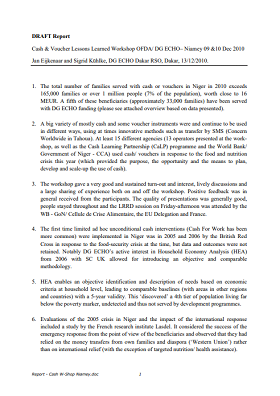
Cash & voucher lessons learned workshop OFDA/ DG ECHO
Report
An overview of discussions of the Cash & voucher lessons learned workshop OFDA/ DG ECHO – Niamey 09 &10 Dec 2010.
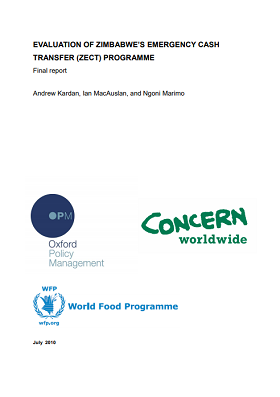
Evaluation of Zimbabwe’s Emergency Cash Transfer (ZECT) Programme
Case Study
Concern Worldwide have been delivering food aid in three rural districts of Zimbabwe (Gokwe North, Gokwe South and Nyanga) since 2002 as part of the World Food Programme’s (WFP) Vulnerable Group Feeding (VGF) programme. The VGF provided a monthly food bundle of 10kg staple, 1kg beans and 600ml oil per...
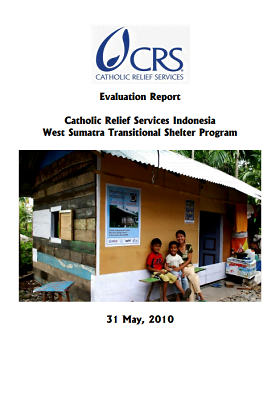
Catholic Relief Services Indonesia West Sumatra Transitional Shelter Program
Report
This evaluation report looks at CRS’ shelter programme in West Sumatra following an earthquake, which used cash grants to assist households to build safe, adequate, comfortable and durable transitional shelters. The report gives an overview of the programme and presents the findings from a comprehensive...
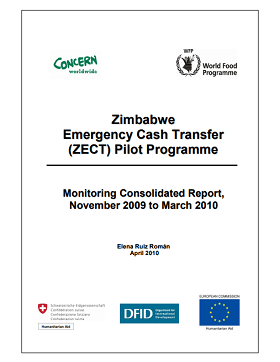
Zimbabwe Emergency Cash Transfer (ZECT) Pilot Programme: Monitoring Consolidated Report, November 2009 to March 2010
Case Study
Concern Worldwide Zimbabwe together with WFP implemented the Zimbabwe Emergency Cash Transfer (ZECT) Pilot Programme in three districts of Zimbabwe as part of the Vulnerable Feeding Group intervention for the food shortages of 2009/2010. In spite of its limited duration (5 months), the ZECT was highly...

Responding to High Food Prices: Evidence from a Voucher Programme in Burkina Faso
Report
In February 2009, WFP launched its first food voucher operation in Africa, to address food security in an urban environment where food is available but beyond the reach of many because of high food prices. Vulnerable segments of the population, who were spending most of their budgets on food, risked...
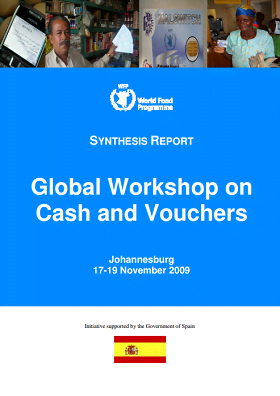
WFP Global Workshop on Cash and Vouchers
Report
This document provides a summary and synthesis of key outcomes and emerging priorities. It also provides a summary of the current status of voucher and cash programming in WFP. A discussion of key emerging cross-cutting issues follows. Strategic priorities for WFP voucher and cash programming and policy...
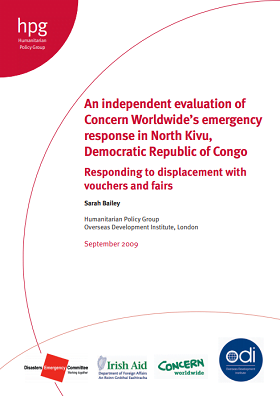
An independent evaluation of Concern Worldwide’s emergency response in North Kivu, Democratic Republic of Congo: Responding to displacement with vouchers and fairs
Case Study
In late 2008, escalated fighting among rebels and the Congolese Armed Forces (FARCD) provoked renewed and widespread displacement in North Kivu province, Democratic Republic of Congo (DRC). In response to the unfolding crisis, Concern Worldwide implemented the project Emergency Assistance to Newly...

Fresh food vouchers for refugees in Kenya
Report
Read the report here This article in Field Exchange magazine outlines an intervention by ACF in Dadaab to improve the nutritional intake and dietary diversity of the refugee population of Dadaab, Kenya, through a complementary food voucher scheme targeted at malnourished children.

Niger: Food Security and Safety Nets
Case Study
From the perspective of social protection, this study is designed to synthesize considerable existing analysis, review food and nutrition security policies and programs in Niger, and provide an action plan for strengthening the existing system and developing an effective food security and safety net...